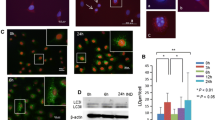Abstract
The lysosomal membrane encloses numerous hydrolytic enzymes and prevents the cytoplasm from being damaged by these enzymes. It is possible that the fragility of this membrane may be implicated in the pathogenesis of gastric mucosal damage. We investigated the effects of 16,16-dimethyl prostaglandin E2 (dmPGE2), which is known to protect the gastric mucosa from various noxious agents, on lysosomal membrane stability in the rat stomach. Sodium taurocholate (TC) was used as the damaging agent. To assess lysosomal membrane stability in the gastric mucosa, we assayed acid phosphatase released from lysosomes isolated from a gastric mucosal homogenate. To assess lysosomal membrane stability in gastric surface epithelial cells, we used laser scanning confocal microscopy to observe the fading of red fluorescence in living cells vitally stained with acridine orange. Exogenous dmPGE2 enhanced lysosomal membrane stability in the gastric mucosa, whereas TC decreased it. In gastric surface epithelial cells, exogenous dmPGE2 protected the cells against TC-induced damage and prevented TC-induced decreased lysosmal membrane stability. It was concluded that a decrease in lysosomal membrane stability seemed to be closely involved in the pathogenesis of gastric mucosal damage. Moreover, it appears that stabilization of the lysosomal membrane by exogenous dmPGE2 may contribute to its protective effect in the gastric mucosa, both at the level of gastric surface epithelial cells and in regard to the entire gastric mucosa.
Similar content being viewed by others
References
de Duve C. The lysosome. Sci Am 1963;208:64–72.
Kornfeld S, Mellman I. The biogenesis of lysosomes. Annu Rev Cell Biol 1989;5:483–525.
Ferguson WW, Edmonds AW, Starling JR, Wangensteen SL. Protective effect of prostaglandin E1 (PGE1) on lysosomal enzyme release in serotonin-induced gastric ulceration. Ann Surg 1973;177:648–654.
Waldron-Edward D, Boutros MIR, Himal HS. Effect of bile on lysosomal stability in the mucosa of the canine gastric antrum. Gastroenterology 1977;73:980–984.
Himal HS, Mowat C. Prostaglandin cytoprotection and lysosomal stability in acute canine gastric erosions. Can J Sur 1983; 26:142–143.
Robert A, Nezamis JE, Lancaster C, Hanchar AJ. Cytoprotection by prostaglandins in rats. Gastroenterology 1979;77:433–443.
Miller TA, Jacobson ED. Gastrointestinal cytoprotection by prostaglandins. Gut 1979;20:75–87.
Lacy ER, Ito S. Microscopic analysis of ethanol damage to rat gastric mucosa after treatment with a prostaglandin. Gastroenterology 1982;83:619–625.
Terano A, Ota S, Mach T, et al. Prostaglandin protects against taurocholate-induced damage to rat gastric mucosal cell culture. Gastroenterology 1987;92:669–677.
Ignarro LJ. Effects of anti-inflammatory drugs on the stability of rat liver lysosomes in vitro. Biochem Pharmacol 1971;20:2847–2860.
Torriani A. Influence of inorganic phosphate in the formation of phosphatases byEscherichia coli. Biochim Biophys Acta 1960; 38:460–469.
Saitoh O, Maemura K, Ohshiba S, Fukuda M. Role of lysosomal membrane glycoproteins in defense mechanisms of human colon cancer cells. Cytoprotect Cytobiol 1992;10:225–230.
Matuoka K, Tanaka M, Mitsui Y, Murota S. Cultured rabbit gastric epithelial cells producing prostaglandin I2. Gastroenterology 1983;84:498–505.
Mosmann T. Rapid colorimetric assay for cellular growth and survival: Application to proliferation and cytotoxicity assay. J Immunol Methods 1983[65:55–63.
Ota S, Tsukahara H, Terano A, et al. Protective effect of tauroursodeoxycholate against chenodeoxycholate-induced damage to cultured rabbit gastric cells. Dig Dis Sci 1991;36: 409–416.
Allison AC, Young MR. Uptake of dyes and drugs by living cells in culture. Life Sci 1964;3:1407–1414.
Rundquist I, Olsson M, Brunk U. Cytofluorometric quantitation of acridine orange uptake by cultured cells. Acta Pathol Microbiol Scand (A) 1984;92:303–309.
Cure IN. Inereased resistance of the gastric mucosal barrier to barrier breakers in the rat. Gastroenterology 1979;77:309–312.
Angerson WJ, Geraghty JG, Carter DC. Taurocholate-induced gastric mucosal injuries in experimental portal hypertension. Gut 1992;33:170–174.
Soll AH, Whittle BJR. Interaction between prostaglandins and cyclic AMP in the gastric mucosa. Prostaglandin 1981;21[Suppl]: 39–45.
Konturek SJ, Brzozowski T, Radecki T, Dobrzanska M. Generation of endogenous prostaglandins and thromboxanes in taurocholate-induced gastric mucosal lesion. Scand J Gastroenterol 1984;19:91–96.
Mutoh H, Hiraishi H, Ota S, et al. Role of oxygen radicals in ethanol-induced damage to cultured gastric mucosal cells. Am J Physiol 1990;258:G603-G609.
Mutoh H, Hiraishi H, Ota S, et al. Protective role of intracellular glutathione against ethanol-induced damage in cultured rat gastric mucosal cells. Gastroenterology 1990;98:1452–1459.
Mutoh H, Ota S, Hiraishi H, et al. Reduced glutathione protects cultured gastric mucosal cells from suckling rats against acid. Am J Physiol 1991;261:G65-G70.
Arakawa T, Fukuda T, Nakamura A, et al. Protection by 16,16-dimethyl PGE2 of surface epithelial, parietal, and chief cells isolated from rat stomach (in Japanese with English abstract). Jpn J Gastroenterol 1989;86:1031–1036.
Konda Y, Nishisaki H, Nakano O, et al. Prostaglandin protects isolated guinea pig chief cells against ethanol injury via an increase in diacylglycerol. J Clin Invest 1990;86:1897–1903.
Fantone JC, Marasco WA, Elgas, LJ, Ward PA. Stimulus specificity of prostaglandin inhibition of rabbit polymorphonuclear leukocyte lysosomal enzyme release and superoxide anion production. Am J Pathol 1984;115:9–16.
Hogaboam CM, Bissonnette EY, Chin BC, et al. Prostaglandins inhibit inflammatory mediator release from rat mast cells. Gastroenterology 1993;104:122–129.
Takamatsu T, Fujita S. Confocal laser scanning microscopy for image cytometry (in Japanese with English abstract). Nippon Rinsho (Jpn J Clin Med) 1992;50:2524–2546.
Author information
Authors and Affiliations
Rights and permissions
About this article
Cite this article
Saitoh, O., Nakagawa, K., Asada, S. et al. Effects of 16, 16-dimethyl prostaglandin E2 on lysosomal membrane stability in rat stomach. J Gastroenterol 29, 703–709 (1994). https://doi.org/10.1007/BF02349274
Received:
Accepted:
Issue Date:
DOI: https://doi.org/10.1007/BF02349274




